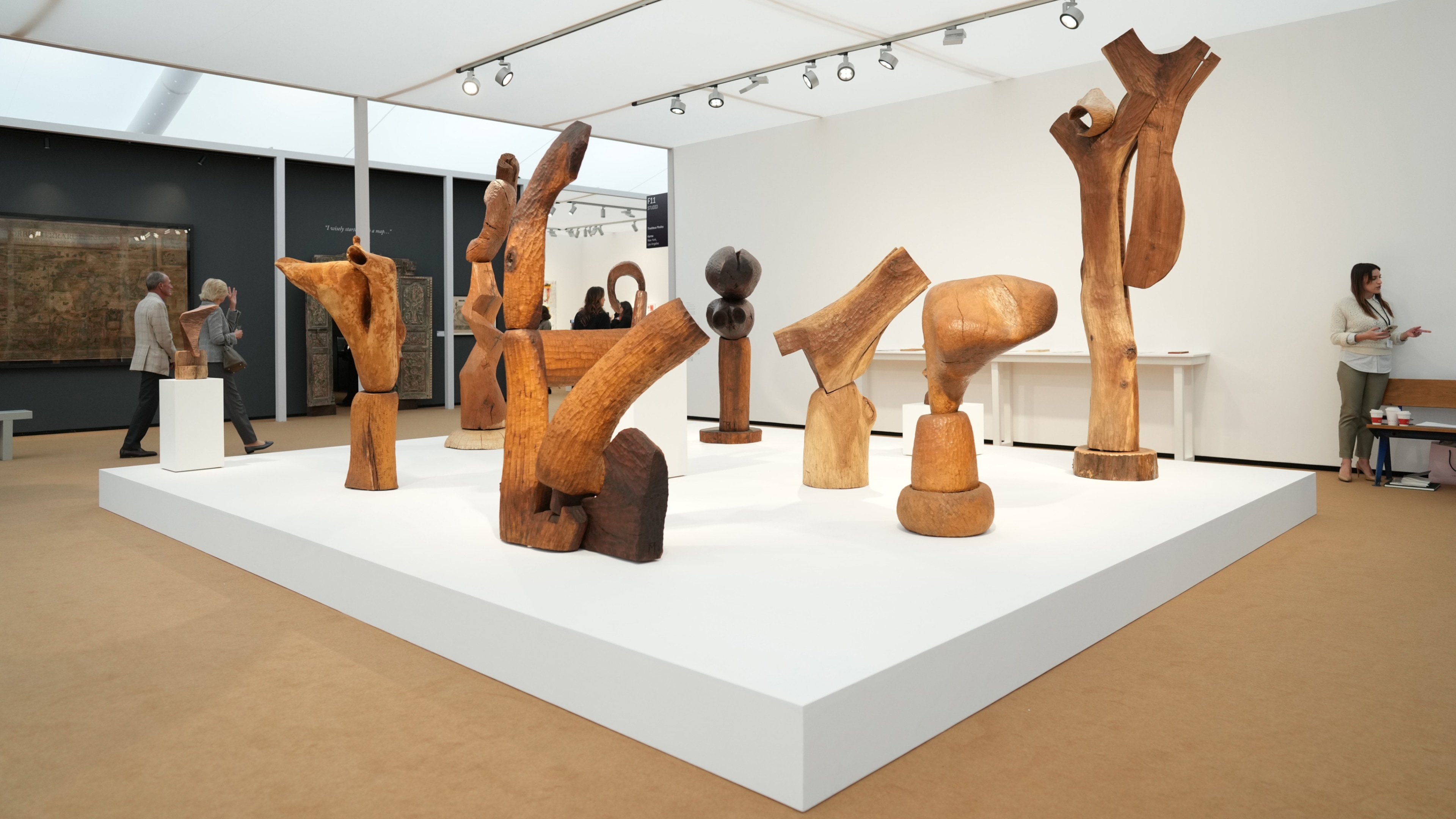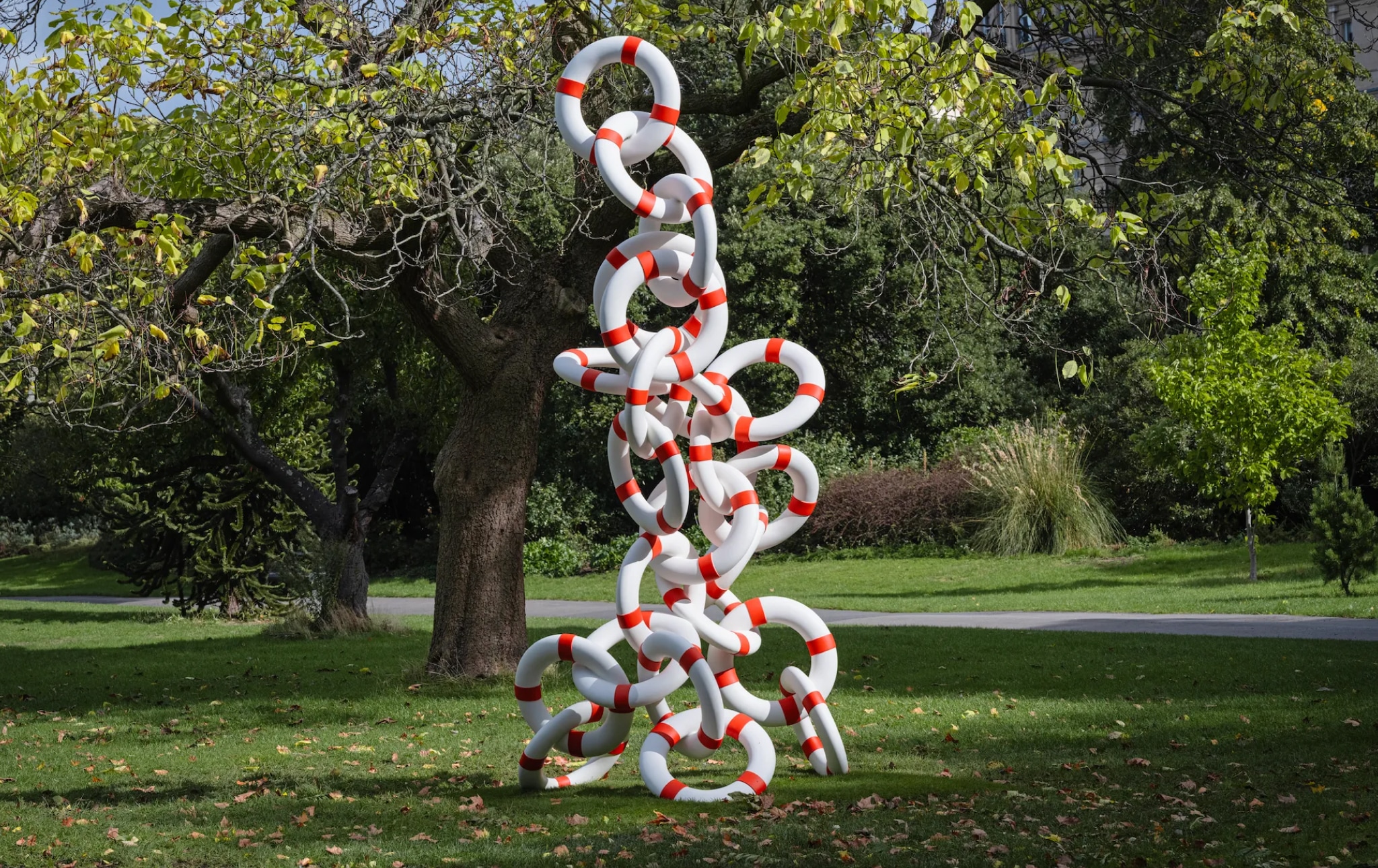Frieze London 2025: Where Shadows, Scale and Storytelling Remake the City’s Cultural Map

In 2025 the Frieze season stretches longer than ever: Frieze Sculpture opens on 17 September and runs through 2 November, spreading works across the English Gardens, while Frieze London and Frieze Masters convene in Regent’s Park from 15-19 October, together staging one of the most consequential cultural moments of the autumn.
This year’s Frieze is framed by a theme of absence and presence. The sculpture programme, curated by Fatoş Üstek and titled In the Shadows, invites visitors to experience how light, material and context make and unmake meaning in public space. The tented fairs in October continue that conversation, where contemporary risk meets historical weight, and where curatorial ambition and market activity entwine.
Sculpture in the Park: Public Art Reimagined
Frieze Sculpture has, over the last decade, shifted from a seasonal curiosity to a major public art commission, free to all, sited in the English Gardens so that encounters feel casual and inevitable. The 2025 edition is no exception: the trail of fourteen international artists is conceived as a meditation on thresholds, memory and material, and the works have been chosen to engage with the changing light and weather of the season.
Among the confirmed installations, Elmgreen & Dragset’s monumental Life Rings, Fig.3 arrives courtesy of Pace, an uncanny tower of life-saving rings that reads at once as satire and civic monument, throwing questions about safety, visibility and spectacle into the park’s green interior. Nearby, Assemble’s Fibredog, a large, processional piece made in collaboration with UniFor and Plinth, places a community-minded practice in the public realm, inviting participation and reflection on material heritage. These two works alone set the tone for a sculpture programme that is neither quaint nor merely decorative; it is conversational, challenging, and wholly public.
Because it runs from late September into November, Frieze Sculpture changes with the light. A bronze that reads as quiet geometry in September can throw long, uncanny shadows in mid-October; a suspended work invites different readings at noon and at dusk. This temporal quality is central to the curatorial idea: shadows are not empty space but an active register of meaning, and visitors are invited to move through that register, day by day.

Tents and Conversations: Frieze London & Frieze Masters
When the fair tents come alive in mid-October, the conversation becomes denser. Frieze London showcases the leading contemporary galleries alongside a robust Focus programme for younger spaces; Frieze Masters assembles work spanning millennia, with a newly invigorated directorship bringing fresh curatorial priorities. This year both fairs are explicitly aligning artist-centred programmes with broader cultural questions, drawing attention to voices long outside the mainstream as well as to the craft of the historical canon.
Artist-to-Artist returns as a highlight of Frieze London’s peer-curated programming, with six solo presentations nominated by leading practitioners. This year’s selectors, Camille Henrot, Nicole Eisenman, Abraham Cruzvillegas, Chris Ofili, Amy Sherald and Bharti Kher, continue to signal Frieze’s commitment to artist-led exchange, making the booths themselves sites of pedagogy and peer endorsement. Parallel to that, the themed section Echoes in the Present, curated by Dr. Jareh Das, spotlights artists tracing lineages between Brazil, Africa and their diasporas, a reminder that histories of movement and exchange are central to contemporary practice. These curatorial choices ensure that Frieze is not merely a marketplace; it is an argument about how we read art, history and place.
Across the two fairs, the scale is impressive: more than 280 galleries from dozens of countries converge on the park, creating an ecosystem where discovery, commerce and debate coexist. Yet the scale belies the intimacy of many encounters: gallery booths where an artist speaks at length about process, an archivist who opens a box of photographs for a museum director, a private broker introducing an institutional curator to a work they’ve long sought.
Artist Spotlights: Where Craft Meets Urgency
There is no single aesthetic that defines Frieze 2025. What unites many works is a concern with material, memory, and the imagination’s capacity to work with both. Elmgreen & Dragset’s Life Rings repurposes an object associated with emergency into a public monument, simultaneously absurd and haunting. Assemble’s Fibredog roots collective making within the park itself, bringing craft and social practice into dialogue with high art.
Elsewhere on the trail and within the tents, visitors will encounter artists whose practices negotiate ecological fragility and cultural inheritance. You may find works that use reclaimed materials to suggest histories of extraction, paintings that fold private narratives into national ones, and audiovisual pieces that make sound and silence part of their structure. In Frieze Masters, curated sections such as Reflections and Spotlight encourage rediscovery and re-evaluation, pairing lesser-seen historical works with contemporary responses in a way that feels generative rather than retrograde.
The Market and the Museum: Why Frieze Still Matters
For many, Frieze functions as a barometer: which artists are commanding attention, which galleries are expanding, and how are institutions and private buyers aligning their acquisitions? The fair week is as much about conversation as commerce, collectors quietly confirm deals in booth backrooms, museum curators mark a younger artist for future acquisition, and advisors scout the Focus section for artists whose work might be appreciated both culturally and financially.
London’s continued centrality to the global art market is evident in the types of visitors who pour into Regent’s Park. Despite geopolitical shifts and market gyrations, the city remains a hub where capital, culture and institutional life converge, between private sales, catalogue raisonné conversations, and the excitement of first encounters. Frieze’s timing, positioned ahead of major autumn auctions and amid the capital’s seasonal programming, ensures it plays an outsized role in shaping the year ahead for artists and institutions alike.
The Rhythm of Frieze Week: How to Move Through It
There is an art to attending Frieze. Mornings are for measured walks through the Sculpture trail when the park is quieter and light reveals subtle works. Afternoons bring the tents alive: a talk in the Frieze Talks programme, a curated walkthrough with a director, a coffee and a conversation with a gallery owner about provenance. Evenings in London’s art week are a braided life of private viewings, discreet dinners where acquisitions are celebrated, and performance-based interventions that spill out into the night.
Beyond the formal schedule, citywide programming, museum exhibitions, project spaces, pop-ups, create a perimeter that makes Frieze feel like the seed of a larger cultural season. The fair is the gravitational centre, but the orbit is wide: Serpentine, Tate, the Royal Academy and smaller experimental spaces all respond in kind, hosting shows and events that enrich the fair’s themes.
LLC Global: The Invisible Architecture of Presence
In this environment, travel logistics are not secondary; they are part of the choreography. For collectors, curators and artists operating on tight schedules, a delayed arrival can mean a missed conversation or a lost opportunity. This is where LLC positions itself as more than a transport provider: it is a curator of time and discretion. LLC offers tailored, multi-stop itineraries to move guests through previews, gallery visits and private dinners with minimal friction, and vehicles that function as mobile sanctuaries, quiet, connected, and secure.
LLC’s service isn’t simply about punctuality. It is about reading the cadence of the week: anticipating a schedule change, creating private spaces in which a collector can make quick calls, or providing a discreet drop-off prior to a closed viewing. For guests who wish to make a statement without spectacle, a Rolls-Royce or Bentley waiting at the curb reads as both respect and restraint; for those who want to experience London’s streets, a supercar hire becomes part of a cultivated arrival. In short, effective mobility amplifies presence rather than distracts from it.

Sustainability, Shadows and Accountability
Frieze’s In the Shadows theme nudges the fair toward ecological and ethical questions. Many artists working in public and private programmes use reclaimed materials or engage with narratives of displacement and environmental change. The sculpture trail’s public setting in a Royal Park invites conversations about stewardship of green spaces and the role of art in public life, questions that move beyond aesthetics into civic responsibility.
Service providers respond too. LLC has been growing its low-emission fleet, electric luxury sedans such as the Mercedes-Benz EQS, offering clients a way to align mobility with values. The point is not virtue signalling but coherence: when an art fair foregrounds environmental histories and the public realm, the logistical ecosystem around it must reflect similar concerns.
Cultural & Economic Impact: Frieze and London’s Creative Economy
Frieze is more than a fair; it is an engine in London’s cultural economy. Galleries generate sales and commissions; hotels and restaurants benefit from an influx of high-spending visitors; private viewings and dinners sustain a network of freelancers, caterers and technicians whose work underpins the industry. At a macro level, Frieze reinforces London’s status as a global cultural capital, an assertion of soft power that ripples into tourism, philanthropy, and the city’s international reputation.
Collectors’ habits often change at fairs. Institutions watching purchases can shape future acquisitions, and there is a trickle-down effect: a new market for a younger artist in Focus can feed critical attention, gallery representation and later institutional exhibitions. This cycle, artist, gallery, collector, museum, teases out careers and sustains the cultural ecosystem. By amplifying under-represented voices, Frieze also leverages capital to generate cultural plurality, which in turn enriches the city’s creative output and long-term cultural capital.
What You’ll Take Home
When the tents are taken down and the park returns to calmer rhythms, what remains is not only the commerce recorded in private ledgers but the intellectual gain: new ways of seeing, a restored relationship to public space,and the acquisition of work that may reframe a collector’s holdings or a curator’s programme. Perhaps a sculpture that changed with the autumn light will reconfigure how you think about permanence; perhaps a historical work at Frieze Masters will reframe how you understand a living artist.
And if you moved through the week with a considered transport partner, one that anticipates, protects privacy and aligns logistical choices with the values the fair raises, then the experience will have felt seamless, unhurried and attentively designed. That is the kind of care that allows art to be the centerpiece, not the logistics.
Contact us

